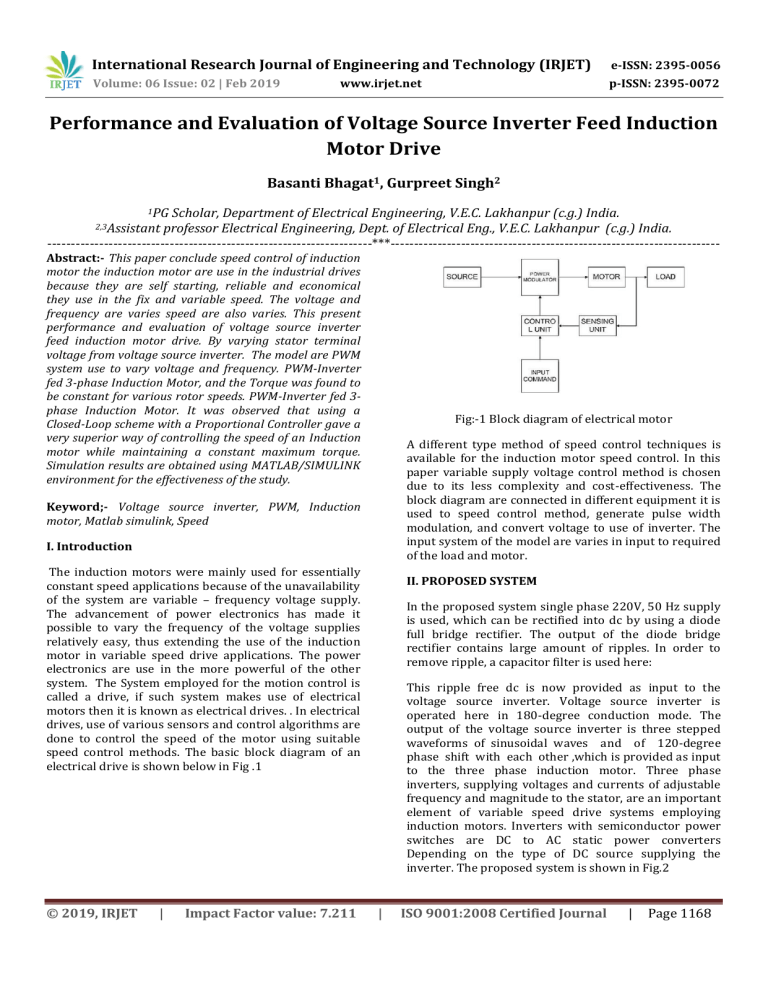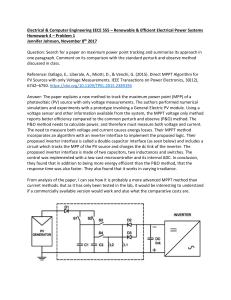
International Research Journal of Engineering and Technology (IRJET)
e-ISSN: 2395-0056
Volume: 06 Issue: 02 | Feb 2019
p-ISSN: 2395-0072
www.irjet.net
Performance and Evaluation of Voltage Source Inverter Feed Induction
Motor Drive
Basanti Bhagat1, Gurpreet Singh2
1PG
Scholar, Department of Electrical Engineering, V.E.C. Lakhanpur (c.g.) India.
professor Electrical Engineering, Dept. of Electrical Eng., V.E.C. Lakhanpur (c.g.) India.
---------------------------------------------------------------------***---------------------------------------------------------------------2,3Assistant
Abstract:- This paper conclude speed control of induction
motor the induction motor are use in the industrial drives
because they are self starting, reliable and economical
they use in the fix and variable speed. The voltage and
frequency are varies speed are also varies. This present
performance and evaluation of voltage source inverter
feed induction motor drive. By varying stator terminal
voltage from voltage source inverter. The model are PWM
system use to vary voltage and frequency. PWM-Inverter
fed 3-phase Induction Motor, and the Torque was found to
be constant for various rotor speeds. PWM-Inverter fed 3phase Induction Motor. It was observed that using a
Closed-Loop scheme with a Proportional Controller gave a
very superior way of controlling the speed of an Induction
motor while maintaining a constant maximum torque.
Simulation results are obtained using MATLAB/SIMULINK
environment for the effectiveness of the study.
Fig:-1 Block diagram of electrical motor
A different type method of speed control techniques is
available for the induction motor speed control. In this
paper variable supply voltage control method is chosen
due to its less complexity and cost-effectiveness. The
block diagram are connected in different equipment it is
used to speed control method, generate pulse width
modulation, and convert voltage to use of inverter. The
input system of the model are varies in input to required
of the load and motor.
Keyword;- Voltage source inverter, PWM, Induction
motor, Matlab simulink, Speed
I. Introduction
The induction motors were mainly used for essentially
constant speed applications because of the unavailability
of the system are variable – frequency voltage supply.
The advancement of power electronics has made it
possible to vary the frequency of the voltage supplies
relatively easy, thus extending the use of the induction
motor in variable speed drive applications. The power
electronics are use in the more powerful of the other
system. The System employed for the motion control is
called a drive, if such system makes use of electrical
motors then it is known as electrical drives. . In electrical
drives, use of various sensors and control algorithms are
done to control the speed of the motor using suitable
speed control methods. The basic block diagram of an
electrical drive is shown below in Fig .1
© 2019, IRJET
|
Impact Factor value: 7.211
II. PROPOSED SYSTEM
In the proposed system single phase 220V, 50 Hz supply
is used, which can be rectified into dc by using a diode
full bridge rectifier. The output of the diode bridge
rectifier contains large amount of ripples. In order to
remove ripple, a capacitor filter is used here:
This ripple free dc is now provided as input to the
voltage source inverter. Voltage source inverter is
operated here in 180-degree conduction mode. The
output of the voltage source inverter is three stepped
waveforms of sinusoidal waves and of 120-degree
phase shift with each other ,which is provided as input
to the three phase induction motor. Three phase
inverters, supplying voltages and currents of adjustable
frequency and magnitude to the stator, are an important
element of variable speed drive systems employing
induction motors. Inverters with semiconductor power
switches are DC to AC static power converters
Depending on the type of DC source supplying the
inverter. The proposed system is shown in Fig.2
|
ISO 9001:2008 Certified Journal
|
Page 1168
International Research Journal of Engineering and Technology (IRJET)
e-ISSN: 2395-0056
Volume: 06 Issue: 02 | Feb 2019
p-ISSN: 2395-0072
www.irjet.net
VSIs can be either voltage or current controlled. In a
voltage controlled inverter, it is the frequency and
magnitude of the fundamental of the output voltage that
is adjusted. Feed forward voltage control is employed,
since the inverter voltage is dependent only on the
supply voltage and the states of the inverter switches,
and, therefore accurately predictable.
The voltage source inverter is a somewhat older design
and
less
expensive
to
implement.
Various
implementation of the VSI are also known as six step,
twelve –step, or even eighteen -step inverters. Voltage
source inverter is operated in 180 degree conduction
mode here, Each switch is operated for 180 degrees. No
two switches in the same leg are operated
simultaneously. At any time instant three switches are
on in this mode. The gating signals and the resulting line
voltages for stepped wave inverter in 180 degree
conduction mode are shown in Figure .4
Fig:- 2 Proposed system
A.VSI OPERATION
Three phase inverters, supplying voltages and currents
of adjustable frequency and magnitude to the stator, are
an important element of variable speed drive systems
employing
induction
motors.
Inverters
with
semiconductor power switches are DC to AC static power
converters. Depending on the type of DC source
supplying the inverter, they can be classified as voltage
source inverter (VSI) and current source inverter (CSI).
In practice, the DC source is usually a rectifier, typically
of the three phase bridge configuration, with DC link
connected between the rectifier and inverter. The DC
link is a simple inductive, capacitive, inductive-capacitive
low-pass filter. Since neither the voltage across a
capacitor nor the current through an inductor can
change instantaneously. A capacitive output DC link is
used for a VSI and an inductive-output link is employed
in CSI. The voltages Va, Vb, and Vc are the output
voltages applied to the windings of a motor.S1 through
S6 are the six power transistors which are controlled by
a, a’ , b, b and c, c’ gating signals and shape the output
voltages. When an upper transistor is switched on, that
is, when a, b, and c are 1, the corresponding lower
transistor is switched off, that is, the corresponding a’ ,
b’ or c’ is 0. The ON and OFF states of upper transistor
S1, S3 and S5, or the states to evaluate the output
voltage. The structure of a typical three-phase voltage
source inverter is shown in Figure 3
Fig:- 3 Three phase voltage source inverter with
induction motor
© 2019, IRJET
|
Impact Factor value: 7.211
Fig: 4 Conduction of inverter
|
ISO 9001:2008 Certified Journal
|
Page 1169
International Research Journal of Engineering and Technology (IRJET)
e-ISSN: 2395-0056
Volume: 06 Issue: 02 | Feb 2019
p-ISSN: 2395-0072
www.irjet.net
must have 3 phase sinusoidal waves with 1200 phase
shift between them. The model are speed control of
induction motor drive are the variable frequency and
voltage by the system.
B. PULSE WIDTH MODULATION
In the voltage source inverter, the conversion of dc
power to three phase ac power is performed in the
switched mode. This mode consists of power
semiconductor switches which are controlled in an onoff fashion. The actual power flow in each motor phase is
controlled by the duty cycle of the respective switches.
To obtain a suitable duty cycle for each switch, pulse
width modulation is used. Many different methods were
proposed and development of it is still in progress.
IV. SIMULATION RESULTS
The simulation model is done in matlab simulation. The
proposed model are speed control of induction motor by
feed voltage source inverter method in the rating are
increased by comparison of reference paper. In this
paper are conclude by the speed rating increased and
control of motor are very easily. The result is not to
suitable in this paper in that region are mainly follows.
The parameter of element are not apply proper value
then our simulation model are not give suitable graph
then we can apply the all parameter value are correct of
element then the graph will correct, in simulation model.
Wide range of linear operation.
Low content of higher harmonics in voltage and current.
Low frequency harmonics.
Operation in over modulation.
V. CONCLUSION
Reduction of common mode voltage.
Voltage source inverter fed induction motor drive is
simulated. Voltage source inverter can be used to control
the stator terminal voltage by controlling duty ratio of
the switches. Hence stator terminal voltage is varied and
results in speed variation of the motor. By properly
controlling duty ratio desired speed range can be
achieved in the motor.
III. SIMULATION STUDIES
Simulations are done using MATLAB/SIMULINK
software tool for the analysis of speed control using
voltage source inverter and performance of the system
are observed with and without PI controllers in the
system.
VI. FUTURE SCOPE
The simulation of voltage source inverter fed three phase
induction Motor Drive system is done using
MATLAB/SIMULINK. The simulation can also be done
using MATLAB. The hardware is implemented using
micro controller. The hardware can also be implemented
using DSP processor. Vector control or direct torque
control may be implemented using DSP processor to
control the speed of three phase induction motor drive.
REFERENCES
1) F. W. Fuchs, “Some diagnosis methods for
voltage source inverters in variable speed drives
with induction machines-A survey,” in Proc.
29th Annu. Conf. IEEE Ind. Electron. Soc.,
Roanoke, VA, pp. 1378– 1385, Nov. 2003
2) R. A. Hanna and S. Prabhu, “Medium-voltage
adjustable-speed drives users and manufactures
experiences,” IEEE Trans. Ind. Appl., vol. 33, no.
6, pp. 1407–1415, Nov./Dec. 1997.
Fig : - 5 Block diagram of the system
The following figure shows the simulated diagram of the
system.
3) Muhammed H Rahid,”Power electronics, circuits,
devices and applications”, Third edition, Pearson
prentice hall, West florida, 2004.
Gating pulses for the switches are generated in such a
manner that the output of the voltage source inverter
© 2019, IRJET
|
Impact Factor value: 7.211
|
ISO 9001:2008 Certified Journal
|
Page 1170
International Research Journal of Engineering and Technology (IRJET)
e-ISSN: 2395-0056
Volume: 06 Issue: 02 | Feb 2019
p-ISSN: 2395-0072
www.irjet.net
4) Dr. P.S. Bimbhra, “Electrical Machinery”, 7th
Edition, Khanna Publishers, New Delhi, 2010.
7) P. S. Bimbhra,” Power Electronics”, Third
edition, Khanna publishers, Delhi, 2003.
5) M.C. Trigg and C.V. Nayar, “Matlab Simulink
Modelling of a Single-Phase Voltage Controlled
Voltage Source Inverter”, Dept. of Electrical
Engineering, Curtin University of Technology.
8) F. Z. Peng, “Z-Source Inverter,” IEEE transactions
on industry applications, Vol. 39, No. 2, pp. 504510, 2003
9) E. Fitzgerald, Charles Kingsley, Jr. And Stephan
D. Umans, “Electrical Machinery”, McGraw-Hills
Publications, Year 2002.
6) Scott Wade, Matthew W. Dunnigan, and Barry W.
Williams, “Modelling and Simulation of
Induction Machine Vector Control with Rotor
Resistance Identification”, IEEE transactions on
power electronics, vol. 12, no. 3, may 1997.
© 2019, IRJET
|
Impact Factor value: 7.211
10) Gopal K. Dubey, “Fundamentals of Electrical
Drives”, 2nd Edition, Narosa Publishing House,
New Delhi, 2011.
|
ISO 9001:2008 Certified Journal
|
Page 1171





